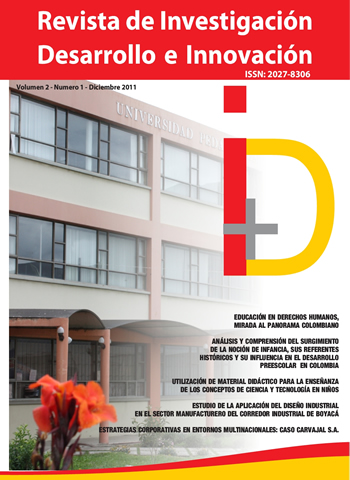Corporate strategy in multinational environments: Carvajal S.A. case

Abstract
This case allows a deeper understanding of corporate strategies in multinational environments, through the study of the Colombian company CarvajalS.A., which reflects a harmony between what we want to become and what it is. Thus, their strategy has enabled it to make better competitive position. By tracking the historical development and from information obtained from the company and previous studies in the same, are identified and validated multinationalization strategies it has implemented to settle in a global environment, which sets out what were the powers that have different and that stand out internationally and discusses how the company has aligned with the global requirements of transparency and management of its corporate governance. To maintain and improve its position in a global environment, this company can among other things, issue shares, analysis of attractiveness, strengthen your marketing strategies, improve knowledge transfer processes, leverage resources, think globally and continue to innovate.
Keywords
Strategy, multinationalization strategies, distinctive competencies, corporate governance.
References
- Brown, G., y Velázquez, A. (2005). The Printer. Latin Trade (English),13(7), 20-22. Extraído el 01 de octubre, 2010, de http://0-web.ebscohost.com.millenium.itesm.mx/bsi/detail?vid=10&hid=11&sid=b3b80154-f83e-48d0-9c0e-e06d545b8f90%40sessionmgr14&bdata=JnNpdGU9YnNpLWxpdmU%3d#toc.
- Brown, P. (2004). “Strategic capability development in the higher education sector” International Journal of Educational Management, 18 (7), 436-45.
- Carvajal S.A. (n.d./2010). Carvajal Historia Viva. Extraído en marzo, 2010, de http://www.carvajal.com.co/empresas-esp/inversionistas/LibroCarvajalHistoriaViva.pdf.
- Dinero, (2010). Carvajal se reinventa. Ed. 354. Extraído en Septiembre, 2010, de http://www.dinero.com/edicion-impresa/caratula/carvajal-reinventa_74523.aspx.
- Calderón, G. (2006). “Competencias distintivas en las pymes: un aporte desde gestión humana”. INNOVAR. Revista de Ciencias Administrativas y Sociales, 16 (027), 57-72.
- Calderón, H., Delgado, E., Gázquez, J., Gómez, M., Jiménez, A., Romero, C., Martínez, M., Mondéjar, J., Pérez, M. y Zapico, L. (2004). Dirección de productos y marcas. Barcelona, España: Editorial UOC.
- Camisón, C. (2002). Las competencias distintivas basadas en activos intangibles En P. Morcillo y J. Fernández Aguado. Dirección estratégica. Barcelona: Editorial Ariel.
- Castañeda, H. (2004). Principales factores en la elaboración y aplicación de la gestión estratégica, análisis teórico y estudio de caso. Universidad Nacional de Colombia, Bogotá.
- Collis, D. & Montgomery, C. (1998). Creating corporate advantage. Harvard Business Review, 76 (3), 71-83. Extraído el 10 de Octubre, 2010, de ABI/INFORM Global.
- Díez, E. y Martín, F. (1995). El comportamiento directivo como competencia distintiva. Investigaciones Europeas de Dirección y Economía de la Empresa, 1 (2), 87-98.
- Dominic, B., Simon, C. & Wong. (2006). Improving board performance in emerging markets. The McKinsey Quarterly, (1), 74-83. Extraído el 18 de Octubre, 2010, de ABI/INFORM Global (ID: 978706731).
- Fernández, Z. (1993). La organización interna como ventaja competitiva para la empresa. Papeles de economía española, 1, (56), 178-193.
- Gaitán, S. (2009). “Gobierno corporativo en Colombia Tendencias actuales”. AD-MINISTER. Revista de la Escuela de Administración, 15, 137-153.
- Hint, M., Ireland, D. & Kisson, R. (1999). Administración estratégica. Conceptos, competitividad y globalización. Internacional Thomson Editores S.A. Tercera Edición.
- Lam, L. y White, L. (1999). An Adaptative Choice model of the internationalization process. The International Journal of Organizational Analysis. 7(2), 105-134.
- Mckiernan, P. (1992). Strategies of growth: Maturity, recovery and internationalization. New York: Routledge.
- Mejía, J., Bouza, T., Raymond, N., Esposito, M., Sama, G., Martinez, L. & Bianchi, A. (2002). Cuentas dudosas: el efecto Enron en Latinoamerica. Mural,p. 7. Extraído el 17 de Octubre, 2010, de Latin American Newsstand (ID: 692669021).
- Morten, H. y Nitin, N. (2004). How to Build Collaborative Advantage. MIT Sloan Management Review, 46(1), 22-30. Extraído el 25 de Octubre, 2010, de ABI/INFORM Global (ID: 715513631).
- Orejuela, J. Mayor, C. & Vesga, J. (2007). Trayectoria de las empresas multinacionales en la ciudad de Cali. Revista Científica Guillermo de Ockham, Julio-Diciembre, 83-103.
- Peteraf, M. (1993). The cornerstones of competitive advantage: A resource-based review. Strategic Management Joumal, 14(23), 179-191.
- Porter, M. (2002/1982) Estrategia competitiva. Técnicas para el análisis de los sectores industriales y de la competencia. Compañía Editorial Continental.
- Rui da Costa. (2006). Responsabilidad Social: un diferenciador competitivo. Economista. Retrieved October 17, 2010, from Latin American Newsstand. (Document ID: 1021813671).
- Thomson, A., Strickland, A. & Gamble, J. (2009). Crafting and Executing Strategy: The Quest For
- Competitive Advatage Seventeenth Edition , McGraw Hill .
- Wheelen, T. y Hunger, D. (2007). Administración estratégica y política de negocios. Conceptos y casos. Decima Edición. Pearson Educación. México.
- Yin, R. (1984/1989). Case Study Research: Design and Methods, Applied social research. Methods Series, Newbury Park CA, Sage.